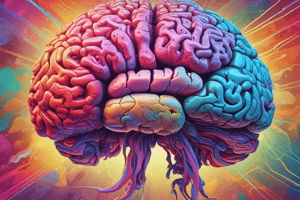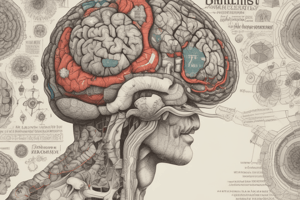Podcast
Questions and Answers
Match the following brain structures with their functions:
Match the following brain structures with their functions:
Occipital Lobe = Visual processing Thalamus = Relay center for sensory information Hypothalamus = Regulating body temperature and hunger Brain Stem = Controlling vital functions like breathing
Match the following brain structures with their locations:
Match the following brain structures with their locations:
Occipital Lobe = Located at the back of the brain Thalamus = Located in the brain stem Hypothalamus = Located just above the thalamus Cerebellum = Located at the back of the brain
Match the following brain structures with their roles:
Match the following brain structures with their roles:
Occipital Lobe = Color perception and spatial relationships Hypothalamus = Regulating sleep and stress response Brain Stem = Controlling heart rate and blood pressure Cerebellum = Coordinating balance and fine motor skills
Match the following brain structures with their involvement in sensory functions:
Match the following brain structures with their involvement in sensory functions:
Match the following brain structures with their cognitive functions:
Match the following brain structures with their cognitive functions:
Flashcards are hidden until you start studying
Study Notes
Brain Lobes and Their Functions
The human brain consists of various structures that work together to support different cognitive processes. These structures can be broadly classified into lobes and regions. In this article, we will discuss the main brain lobes and their functions, including the frontal lobe, parietal lobe, temporal lobe, occipital lobe, Thalamus, Hypothalamus, brain stem, and cerebellum.
Frontal Lobe
The frontal lobe is the largest and most superior lobe of the human brain. It is located in the front of the brain and covers the forehead. The frontal lobe is responsible for executive functions, such as decision-making, judgment, problem-solving, and planning. It is also involved in personality, emotions, and social behavior.
Parietal Lobe
The parietal lobe is located on the side of the brain and is responsible for processing sensory information, such as touch, temperature, and pain. It also plays a role in spatial relationships, integrating information from different senses to create a coherent perception of the world. Additionally, the parietal lobe is involved in attention and language processes.
Temporal Lobe
The temporal lobe is situated on the side of the brain and is involved in auditory processing, including speech perception and comprehension. It is also responsible for memory and emotion, particularly the processing of emotions related to music.
Occipital Lobe
The occipital lobe is located at the back of the brain and is primarily responsible for visual processing. It receives information from the retina and is involved in visual acuity, color perception, and spatial relationships.
Thalamus
The thalamus is a bilateral structure located in the brain stem. It acts as a relay center for sensory information, processing and integrating sensory information before sending it to the cerebral cortex. The thalamus is also involved in motor control and consciousness.
Hypothalamus
The hypothalamus is a small region at the base of the brain, just above the thalamus. It plays a crucial role in regulating various physiological processes, including body temperature, hunger, thirst, sleep, and stress response. It also acts as a link between the nervous system and the endocrine system, controlling the release of hormones from the pituitary gland.
Brain Stem
The brain stem is the lower part of the brain, connecting the brain to the spinal cord. It is responsible for controlling vital functions, such as breathing, heart rate, and blood pressure. It also plays a role in motor functions, including reflexes and posture.
Cerebellum
The cerebellum is located at the back of the brain and is responsible for coordinating motor functions, including balance, posture, and fine motor skills. It also plays a role in timing, learning, and memory.
In conclusion, the human brain is a complex organ with various structures that work together to support a wide range of cognitive and physiological processes. Understanding these structures and their functions can help us better understand the brain and its roles in various aspects of human life.
Studying That Suits You
Use AI to generate personalized quizzes and flashcards to suit your learning preferences.




